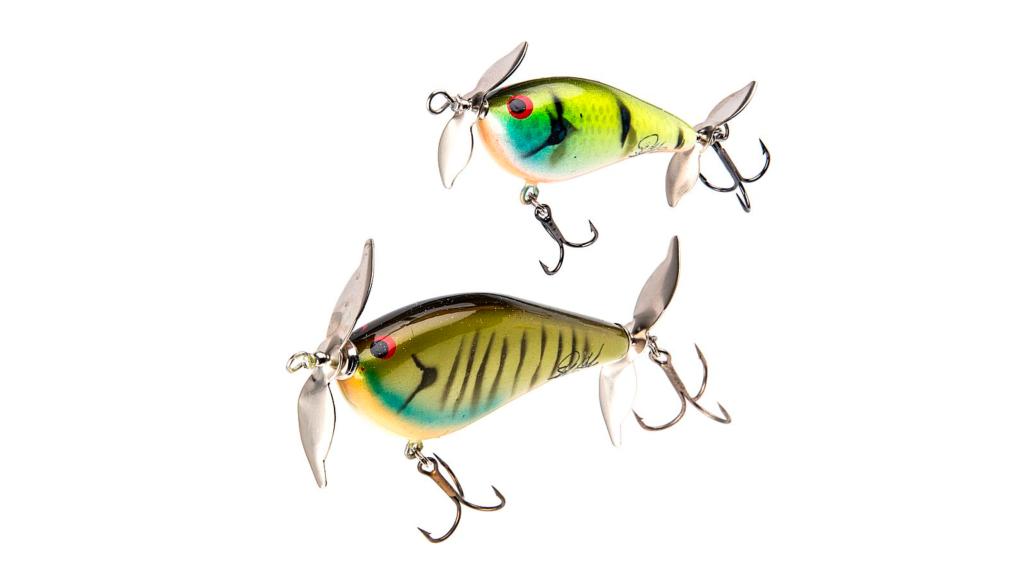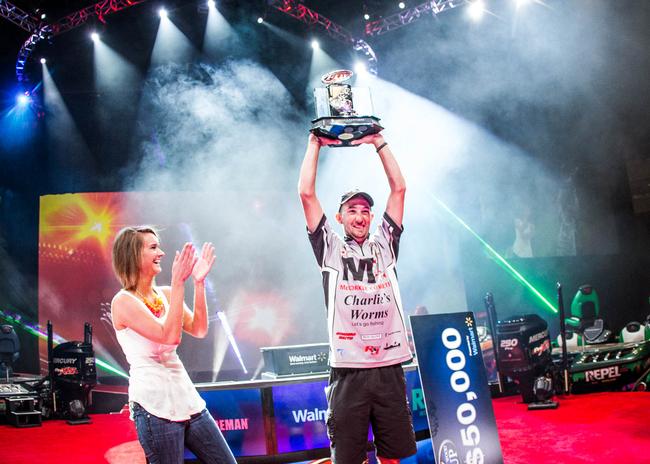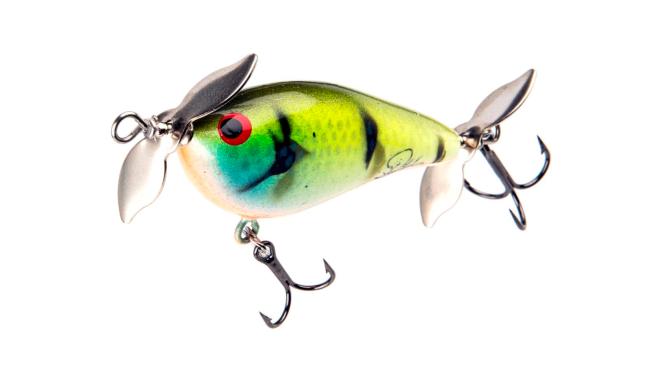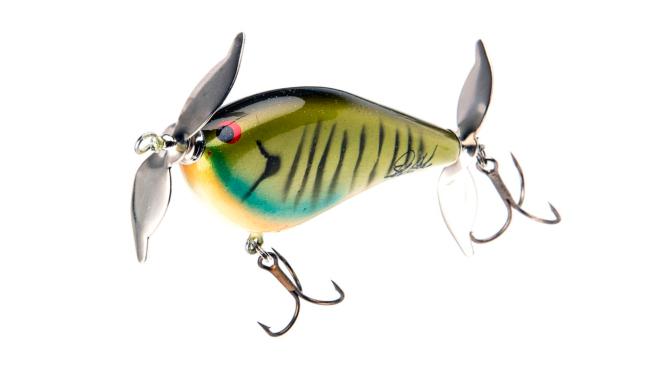How to Fish the Prop Bee
Put this bluegill-imitating prop bait to work now

The Brian’s Bees Prop Bee isn’t the most popular topwater bait on the Walmart FLW Tour. Rather, it’s more limited in scope. It’s a niche bait. When a tournament falls into the window where the Prop Bee shines, however, it’s one of those “you-gotta-have-it” baits that is practically a shoo-in to produce a few top-10 finishes.
As its appearance and shape indicate, the Prop Bee’s niche is as a bream-imitator. It’s a killer on clear-to-slightly-stained waters whenever bass are on a bream-devouring pattern in shallow water, typically throughout summer.
Several companies have produced similarly shaped and styled plastic prop baits, and out-of-production balsa and cedar classics do fetch a hefty sum from anglers who prefer the action of a hand-carved bait. No knocks against any of them, but we thought it would better to put together this primer on how to fish what has become one of the most popular semi-custom baits in the last decade of tournament fishing: the Brian’s Bees Prop Bee.
Reigning Forrest Wood Cup co-angler champion and Carolina Prop Bee slinger Bryan New chimed in with his advice.
The Bait
North Carolina lure maker Brian Huskins created the Prop Bee. It’s fashioned of balsa, like so many great custom baits that have come out of the Carolinas. The body has flat sides and is quite narrow along its length, but when viewed in profile it has a broad bluegill shape with a deep belly.
The Prop Bee comes in four sizes and two models – standard and “Dead,” which has a hook hanger on its side and slightly different action.
New likes the standard No. 3, which is the smallest version at just 2 1/4 inches long.
A two-blade prop is rigged at the front and the back, and the bait ships without hooks. Depending on size, treble hooks of No. 2 to No. 6 will work fine. New prefers Gamakatsu round-bend hooks and hand-ties a feather on the back hook.
Prop Bees aren’t cheap. They sell for around $27 apiece at most online retailers. Their effectiveness in certain situations justifies the cost to most die-hard anglers, however.
Get more information at BriansCrankbaits.com.
Presentation
The Prop Bee isn’t really a walking bait. Most pros fish it with a series of twitches or rips to keep the blades churning water. However, when worked on a short rod with braided line and the right cadence, the No. 3 will kick side-to-side in a subtle walking motion, says New.
“Sometimes I’ll twitch it two or three times and let it sit there,” he adds. “Or I’ll twitch it once and let it sit there. I keep it pretty slow with that bait.”
Tackle
“Tackle is everything, really,” says New.
He’s especially particular about his rod: a 6-foot, 3-inch model that’s part of the brand-new Bryan Thrift Signature Series from Fitzgerald Rods.
It’s short and has a stubby handle for making roll casts under docks and overhanging limbs and other precisely targeted presentations.
New spools up with 20-pound-test Sunline braid with a 3- to 5-foot-long 15-pound-test Sunline Super Natural monofilament leader.
“I use braid for a few reasons,” says New. “Fish hitting a topwater a lot of times are not trying to eat it, but trying to kill it. They’ll hit it with their mouths closed. You might hook them in the side of the mouth or top of the head, and with braid you get a lot better hookset, especially on a long cast. Also, on a long cast braid makes that bait kick to the side and walk better.”
The monofilament leader is less visible in clear water, and because it’s stiffer than braid, will not tangle with the front prop as easily. New cautions strongly against tying limp braid straight to the bait.
When and Where
The Prop Bee is an option anytime bass are feeding on bream near the banks. New considers it to be a “situational” bait that he mixes in with other good bluegill imitators such as a swim jig or Rebel Pop-R.
“I throw the Pop-R when it’s slick and the prop bait when it’s windy and more overcast,” New says. “The prop bait isn’t as subtle. It has a little more noise to it, so bass pick up on it a little better.”
New also says that the Prop Bee is somewhat slow to fish – at least, the way he fishes it – so he’ll cover water with a swim jig or an alternative topwater and uses the Prop Bee as a “target bait.”
Generally, New reaches for the Prop Bee in a few scenarios:
1. When bass are ravaging bream beds.
2. When bass are cruising the banks in “wolf packs” and searching for vulnerable bream.
3. Around shade under overhanging trees and docks.
4. Along stretches of shallow grass and riprap.
The Bream Patterns
In the North Carolina reservoirs Lake Wylie and Lake Norman, which New frequents between Tour events, bream begin spawning in mid- to late May and continue, albeit in lesser numbers, through September.
The timing and areas where bream spawn in other regions vary by geography, lake, species and conditions. Some spawn in deep water, but New looks for shallow spawning colonies that range from clusters of five to seven beds up to bigger groupings of 20 to 30. He finds them in small pockets either off the main lake or in creeks.
In New’s experience, bream don’t spawn next to a particular type of cover on a regular basis, but they do seek out sandy bottoms most of the time. Ideal water clarity is 3 to 5 feet.
“Wolf packs,” or cruisers, are little hunting parties of bass that might number up to five or six, though bass often cruise alone too. New says these are generally the bigger bass, but they’re also very spooky and must be approached very carefully. He prefers to target them on more open “natural” banks rather than banks with lots of docks or other cover because cruising bass have fewer spots to stop and set up on natural banks. He finds most of the cruisers from June through August.
Bream beds can be located visually or by returning to places where bream spawn season after season. Cruisers will hunt in the same pockets as bass that are feeding in the beds.
“The biggest key, whether fishing wolf packs or bream beds, is covering water,” New says. “Everybody talks about how fast Bryan Thrift fishes. Well, I think I fish twice as fast as him. If I’m keying in on cruising fish or wolf packs, I’m going to cruise around the whole pocket where I found a bed.”
Once New locates a bed, that’s when he slows up a bit with the Prop Bee. On the approach, his first cast is often to any kind of cover nearby where a bass might be waiting to slip in and feed. That might be a stick-up or a shade line. Otherwise, he casts to the nearside of the bed first. He doesn’t start by casting clear across the bed because if he was to hook a bass on the far side, New thinks that fighting the hooked fish across the bed could spook other fish or pull them to the boat, making them uncatchable. So he starts on the nearside first and then casts across.
“Most of the time I’m only going to make four or five casts,” he says. “I like to make long casts and stay way off.”
A cruiser takes a different approach. Sometimes the fish’s path or distance doesn’t allow for time to pick up a different bait, so New throws the swim jig or whatever bait is in his hand. But if he has time, he’ll grab the Prop Bee.
“I try to throw way in front of it or past it and bring the bait in front of it but not overtop of it,” says New. “I get lined up on the line he’s swimming on so I can bring it into his view.”
If the fish misses the topwater, New says it’s usually tough to get it to follow up. However, he’ll circle back to the area an hour or two later. Revisiting bream beds and cruising areas is a smart strategy no matter what, because the bass and bluegills will regroup after being caught or after the bass go on a feeding rampage. Thus, they become catchable again throughout the day. Cruisers might not be on the exact same bank, but New says they generally stay in the area if bream are nearby.
The biggest downside to the bream pattern for tournament fishermen is that the bass often don’t replenish. It’s hard to win a multiple-day tournament strictly off a bream pattern, especially when other anglers are on it too or when there’s an offshore bite for schooling fish.
Still, it can produce some giant bass in summertime.
Other Patterns
As mentioned, shade is another good target for a Prop Bee, especially on sunny days. New tries to slip the lure up under the overhangs and fish it directly in the shade, or he’ll work it along a shade line edge.
Emergent bank grass and riprap can be good in summer too, especially in windy or overcast conditions. The key is to fish parallel to the cover with the bait.


